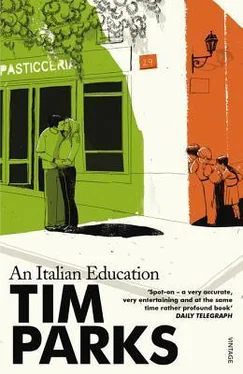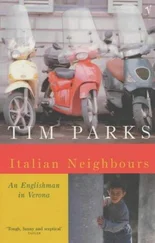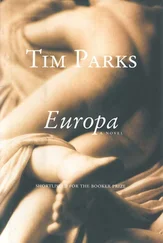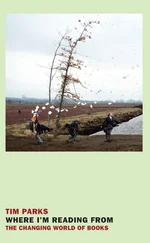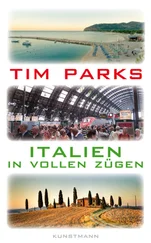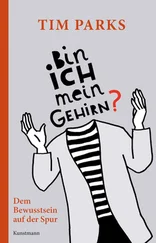Standing at the bar to pay, I am just forcing Michele back into his buggy again (child rearing is such a muddle of caress and coercion) when the boy comes out with the word ‘ mella ’.
‘What was that?’ I ask. For this is a new word.
‘Mella.’
‘What?’
‘ Mella! ’ he yells from a pained red face, reaching up, panting, showing dangerous signs of bursting into tears. In explanation, the girl behind the till reaches over to him with a piece of silver-blue cellophane in her hand. ‘ Caramella ,’ she says. ‘’ Azie ,’ Michele says. And that makes four. With a little more dedication, I suppose, I would be using the occasion to teach him to count.
Sega means saw, segheria , sawmill. Sawmill Road. In the mid-nineteenth century Montecchio was a flourishing industrial area, mainly because of the scores of streams that rise here, providing power for mills and water for the tanning business. Heading south out of the village, Via Segheria begins with a long line of abandoned and partially abandoned factory buildings of the more picturesque variety, one with a fine red-brick chimney some eighty feet high. Opposite this, on the lower slopes of the hill, a builder is putting up twenty or so palazzine of various designs, each forming a pair of semidetached houses, or four of five apartments. Without exception, the roofs are tiled red, the buildings stuccoed white, and each sits in a pool of dove-grey cement surrounded by a garden and properly enclosed by a cement wall topped with sturdy iron railings painted brown. The garage doors are likewise iron and brown. But the volume of the houses is more generous than is usually the case and the spacing decent and above all not of an obvious geometry. I decide to look for the builder, who, according to a sign painted at the bottom of the new road they have opened, is called Righetti, Guglielmo.
Michele is attracted to the sound of a bulldozer digging its way into the hillside. He tugs at my trousers and brum brums. A cement mixer churns merrily, ready to still the whole landscape in a crust of grey. We climb the new road and in one of a line of garages built into the side of a three-storey block, I come across four workmen. They are taking advantage of the shade for an early lunch. There’s the inevitable two-litre wine bottle on an upturned box. They are all in their mid and late fifties, grizzled, weather-beaten, inarticulate. It comes to me that it’s always the older peasant generation doing the actual building here, the hard labour, and doing it mainly for the younger, upwardly mobile generation, who may often be their children. So perhaps, despite having made all the sacrifici in the world to make sure their own children can afford the luxuries of modern housing, these men occasionally drop a little spaghetti on the cotto on purpose, out of a vague resentment, or even, in the teeth of Iacopo’s claims, a sense of humour. The garage, I notice, is quite unnecessarily paved with bright gloss-grey tiles designed to resemble Sardinian granite. It’s the kind of material an English family would feel proud to have in their kitchen.
The extravagant paving of garages… The discrete flaunting of the sensibly superfluous… In such impossible collocations lies the contemporary Italian aesthetic, wealth freezing a world of luxury so still that little children who are all movement can grow up there safe and frustrated.
When I ask the workers a question, they answer in a dialect so strong it’s hard to follow. They come from another time than the one they’re building.
‘Signor Righetti?’
But now there’s the roar of a poorly tuned car and a tiny 126 screeches up in a puff of exhaust. Out climbs a lean young man in yellow shorts and no shirt, battered running shoes on his feet, sardonic smile on smarmy face. Buon giorno, buon giorno . ‘Guglielmo Righetti,’ he says, ‘a pleasure,’ and, immediately, he bends down to go through the who’s-this-fine-young-fella routine with Michele, whom the older men have more soberly ignored. His torso is flat and smooth, wiry rather than muscular. And yes, naturalmente he’ll show me one of the houses. What am I after? Yes, naturalmente the prices are very reasonable. For the kind of quality he’s offering, that is; none of your co operative rubbish. He launches into a well-rehearsed spiel about all the problems involved in buying cooperatives. It was extremely intelligent of me, it seems, not to get tempted into a cooperative. He tells a few horror stories about people losing all their money. ‘And the materials they use!’ Walking along beside him, though, I notice that the drainpipes on his houses are not of copper, as on Stefano’s. When he asks me about my accent and discovers I’m English, he wants to know whether it’s true that the English and Americans still build with wood: wooden frames, wooden floors. Is such a thing possible? Really? The only thing he uses wood for is to make a casing to pour the cement into. Ha, ha! How far behind we must be. And what about the rain? Do they really build in the rain? He shakes his head. The future is in concrete and steel. Erected, naturalmente , under a scorching sun…
Righetti’s style is to mix a too obvious bonhomie with demonstrations of professional superiority. As so often, before I have time to go away and think about it, I’m impressed.
He takes me to a rather attractive-looking building at the top of the street, designed in an L shape. There are three floors, with three apartments on the ground floor and then three more on the next, but these upper apartments have access via spiral staircases to an additional duplex floor under the roof. He shows me one of the larger apartments. We have to go up the space where the staircase will be with a ladder, which sends Michele wild with delight. And it’s curious inside to see how all the pipes and wires are simply set directly into cement then to be covered by tiles or bricks. What will happen if a pipe bursts? ‘My pipes don’t burst,’ Righetti tells me confidently. ‘And my workers are the best in the Veneto. I don’t let just anybody work for me.’ Remembering the men drinking directly from the bottle in the garage, I wonder what the worst workers must be like, and grab Michele just before he plunges down through the hole back to the first floor.
Or am I being unfair? Certainly the windows are solid and handsomely double-glazed. The shutters are the sensible, traditional wooden variety. Looking out from a bedroom, Michele firmly in my arms now (and I fish out a mella from his pocket to keep him quiet), I see that this flat would have an excellent view across a hillside of vines and cherry trees, were it not for the fact that Righetti Guglielmo has started building another large and exactly similar block about fifty yards away, the last in the complex by the looks of it, for there is a perimeter fence just beyond. In particular, it seems to me that the large terrace balcony off the kitchen would be a lovely place to sit if, instead of looking towards it, it was on the other side of that other building.
‘Price?’
‘The place is about 170 square metres,’ he tells me.
Italians tend to judge whether a place is expensive or not on the relationship of price to square metre. Had I been a little more experienced I would have known to bring this size assessment down by about ten percent since, in retrospect, telling me the metres first was a ploy to make the price seem cheap.
‘Yes, but the price?’
‘Less than a million a square metre.’ It’s one of those psychological barriers. Or was, before it became two million a square metre.
‘Can’t you give me the exact figure?’
Читать дальше
